fuel YAMAHA XMAX 125 2021 Owners Manual
[x] Cancel search | Manufacturer: YAMAHA, Model Year: 2021, Model line: XMAX 125, Model: YAMAHA XMAX 125 2021Pages: 114, PDF Size: 13.55 MB
Page 6 of 114
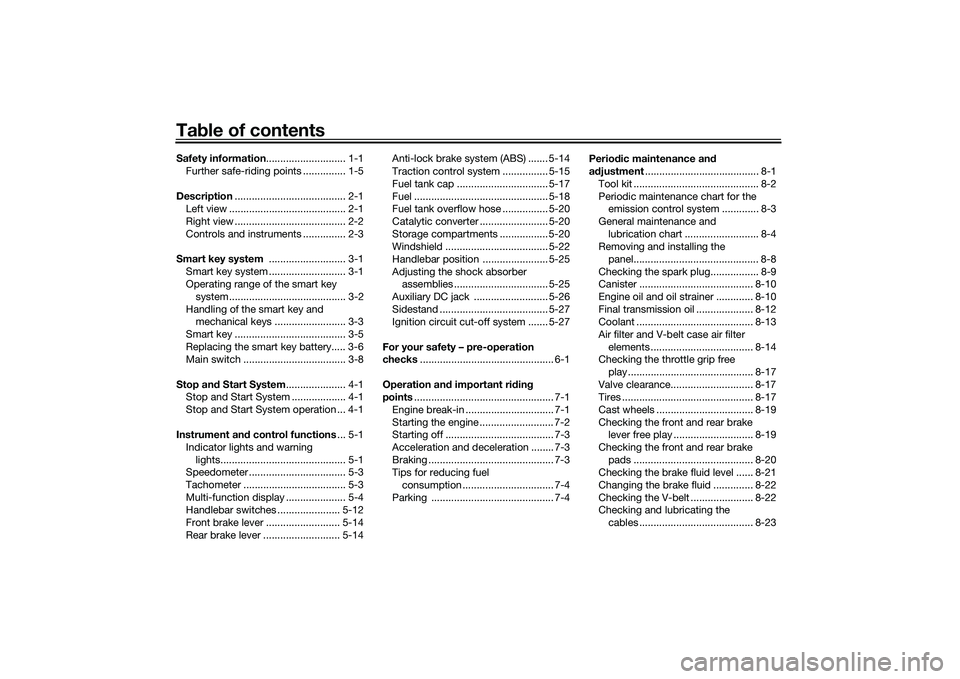
Table of contentsSafety information ............................ 1-1
Further safe-riding points ............... 1-5
Description ....................................... 2-1
Left view ......................................... 2-1
Right view ....................................... 2-2
Controls and instruments ............... 2-3
Smart key system ........................... 3-1
Smart key system ........................... 3-1
Operating range of the smart key system......................................... 3-2
Handling of the smart key and mechanical keys ......................... 3-3
Smart key ....................................... 3-5
Replacing the smart key battery..... 3-6
Main switch .................................... 3-8
Stop an d Start System ..................... 4-1
Stop and Start System ................... 4-1
Stop and Start System operation ... 4-1
Instrument an d control functions ... 5-1
Indicator lights and warning lights............................................ 5-1
Speedometer .................................. 5-3
Tachometer .................................... 5-3
Multi-function display ..................... 5-4
Handlebar switches ...................... 5-12
Front brake lever .......................... 5-14
Rear brake lever ........................... 5-14 Anti-lock brake system (ABS) ....... 5-14
Traction control system ................ 5-15
Fuel tank cap ................................ 5-17
Fuel ............................................... 5-18
Fuel tank overflow hose ................ 5-20
Catalytic converter ........................ 5-20
Storage compartments ................. 5-20
Windshield .................................... 5-22
Handlebar position ....................... 5-25
Adjusting the shock absorber
assemblies ................................. 5-25
Auxiliary DC jack .......................... 5-26
Sidestand ...................................... 5-27
Ignition circuit cut-off system ....... 5-27
For your safety – pre-operation
checks ............................................... 6-1
Operation an d important ri din g
points ................................................. 7-1
Engine break-in ............................... 7-1
Starting the engine .......................... 7-2
Starting off ...................................... 7-3
Acceleration and deceleration ........ 7-3
Braking ............................................ 7-3
Tips for reducing fuel consumption ................................ 7-4
Parking ........................................... 7-4 Perio
dic maintenance an d
a d justment ........................................ 8-1
Tool kit ............................................ 8-2
Periodic maintenance chart for the emission control system ............. 8-3
General maintenance and lubrication chart .......................... 8-4
Removing and installing the
panel............................................ 8-8
Checking the spark plug................. 8-9
Canister ........................................ 8-10
Engine oil and oil strainer ............. 8-10
Final transmission oil .................... 8-12
Coolant ......................................... 8-13
Air filter and V-belt case air filter elements .................................... 8-14
Checking the throttle grip free
play ............................................ 8-17
Valve clearance............................. 8-17
Tires .............................................. 8-17
Cast wheels .................................. 8-19
Checking the front and rear brake lever free play ............................ 8-19
Checking the front and rear brake pads .......................................... 8-20
Checking the brake fluid level ...... 8-21
Changing the brake fluid .............. 8-22
Checking the V-belt ...................... 8-22
Checking and lubricating the
cables ........................................ 8-23UB9YE0E0.book Page 1 Wednesday, January 6, 2021 3:03 PM
Page 15 of 114
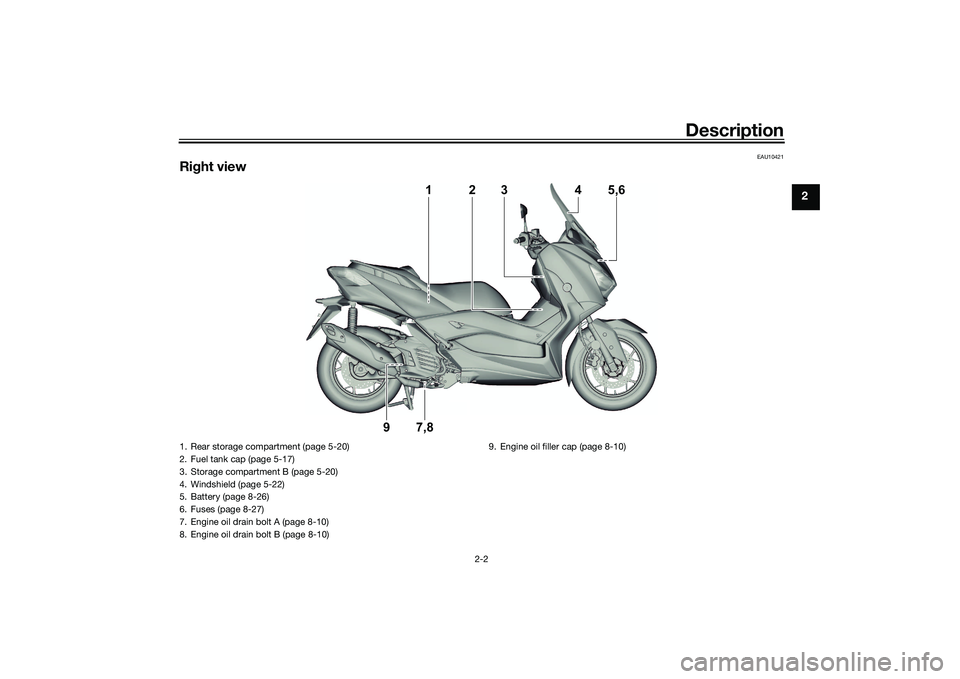
Description
2-2
2
EAU10421
Right view
2
3
4
5,6
1
9
7,8
1. Rear storage compartment (page 5-20)
2. Fuel tank cap (page 5-17)
3. Storage compartment B (page 5-20)
4. Windshield (page 5-22)
5. Battery (page 8-26)
6. Fuses (page 8-27)
7. Engine oil drain bolt A (page 8-10)
8. Engine oil drain bolt B (page 8-10) 9. Engine oil filler cap (page 8-10)
UB9YE0E0.book Page 2 Wednesday, January 6, 2021 3:03 PM
Page 20 of 114

Smart key system
3-4
3need to be replaced at considerable
cost.
Keep the i dentification num ber
car d in a safe place.
NOTICE
ECA21573
The smart key has precision elec-
tronic components. O bserve the fol-
lowin g precautions to prevent
possi ble malfunction or damag e.
Do not place or store the smart
key in a storag e compartment.
The smart key may b e damag ed
from roa d vi brations or exces-
sive heat.
Do not drop, ben d, or su bject
the smart key to stron g impacts.
Do not su bmer ge the smart key
in water or other liqui ds.
Do not place heavy items or ex-
cessive stress on the smart key.
Do not leave the smart key in a
place expose d to direct sun-
li g ht, hi gh temperature or hi gh
humi dity.
Do not g rind or attempt to mo d-
ify the smart key.
Keep the smart key away from
stron g ma gnetic fiel ds an d
ma gnetic o bjects such as key
hol ders, TVs, an d com
puters.
Keep the smart key away from
electric me dical equipment.
Do not allow oils, polishin g
a g ents, fuel, or any stron g
chemicals to come in contact
with the smart key. The smart
key body may become discol-
ore d or cracke d.
TIP The smart key battery life is ap-
proximately two years, but this
may vary according to operating
conditions.
Replace the smart key battery
when the smart key system indi-
cator light flashes for 20 seconds
when the vehicle is turned on, or
when the smart key indicator light
does not come on when the smart
key button is pushed. (See page
3-6.) After changing the smart key
battery, if the smart key system still does not operate, check the
vehicle battery and then have a
Yamaha dealer check the vehicle.
If the smart key continually re-
ceives radio waves, the smart key
battery will discharge quickly. (For
example, when placed in the vicin-
ity of electrical products such as
televisions, radios, or computers.)
You can register up to six smart
keys for the same vehicle. See a
Yamaha dealer regarding spare
smart keys.
If a smart key is lost, contact a
Yamaha dealer immediately to
prevent the vehicle from being
stolen.
UB9YE0E0.book Page 4 Wednesday, January 6, 2021 3:03 PM
Page 24 of 114
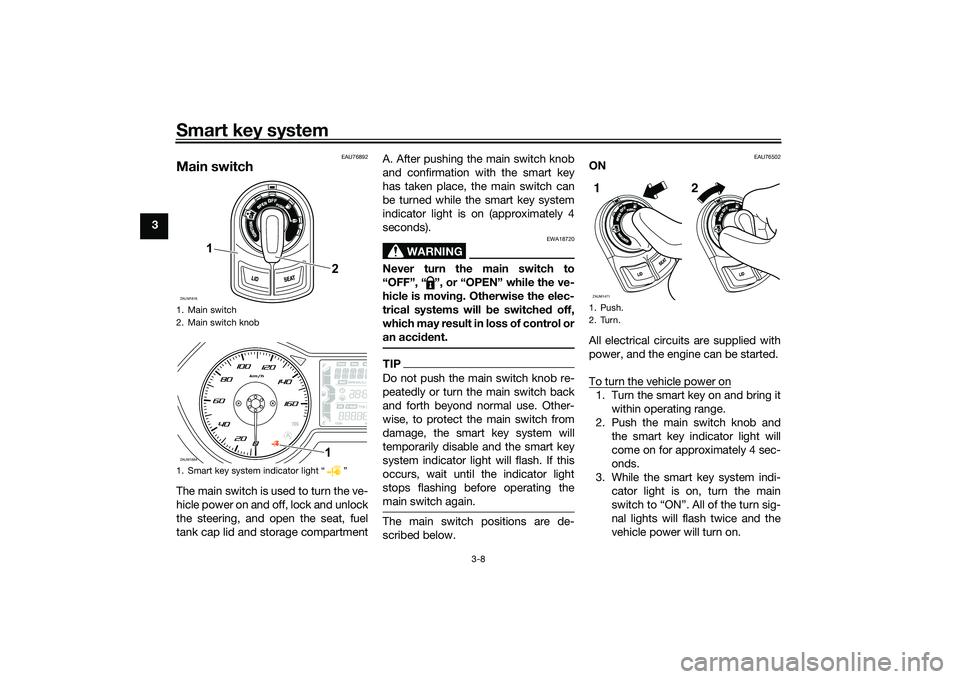
Smart key system
3-8
3
EAU76892
Main switchThe main switch is used to turn the ve-
hicle power on and off, lock and unlock
the steering, and open the seat, fuel
tank cap lid and storage compartmentA. After pushing the main switch knob
and confirmation with the smart key
has taken place, the main switch can
be turned while the smart key system
indicator light is on (approximately 4
seconds).
WARNING
EWA18720
Never turn the main switch to
“OFF”, “ ”, or “OPEN” while the ve-
hicle is movin
g. Otherwise the elec-
trical systems will be switche d off,
which may result in loss of control or
an acci dent.TIPDo not push the main switch knob re-
peatedly or turn the main switch back
and forth beyond normal use. Other-
wise, to protect the main switch from
damage, the smart key system will
temporarily disable and the smart key
system indicator light will flash. If this
occurs, wait until the indicator light
stops flashing before operating the
main switch again.The main switch positions are de-
scribed below.
EAU76502
ON
All electrical circuits are supplied with
power, and the engine can be started.
To turn the vehicle power on1. Turn the smart key on and bring it
within operating range.
2. Push the main switch knob and the smart key indicator light will
come on for approximately 4 sec-
onds.
3. While the smart key system indi- cator light is on, turn the main
switch to “ON”. All of the turn sig-
nal lights will flash twice and the
vehicle power will turn on.
1. Main switch
2. Main switch knob
1. Smart key system indicator light “ ”ZAUM1816
2
1
ZAUM1884
1
1. Push.
2. Turn.ZAUM14711 2
UB9YE0E0.book Page 8 Wednesday, January 6, 2021 3:03 PM
Page 27 of 114

Smart key system
3-11
3
2. With the smart key turned on and
within operating range, push the
main switch knob.
3. While the smart key system indi- cator light is on, push and turn the
main switch to “ ”.
TIPIf the steering will not lock, try turning
the handlebar back to the right slightly.To unlock the steering1. With the smart key turned on andwithin operating range, push the
main switch knob. 2. While the smart key system indi-
cator light is on, push and turn the
main switch to the desired posi-
tion.
EAU79000
“ ” (fuel tank cap li d)
To open the fuel tank cap lid1. With the smart key turned on and within operating range, push the
main switch knob.
2. While the smart key system indi- cator light is on, turn the main
switch to “ ”. To close the fuel tank cap lid
Push the fuel tank cap lid down until it
is closed.TIPMake sure that fuel tank cap lid is se-
curely closed before starting off.
1. Push.
2. Push and turn.ZAUM182012
1. Push.
2. Turn.ZAUM14771
2
UB9YE0E0.book Page 11 Wednesday, January 6, 2021 3:03 PM
Page 28 of 114

Stop and Start System
4-1
4
EAU76825
Stop and Start SystemThe Stop and Start System stops the
engine automatically when the vehicle
is stopped in order to prevent noise,
control exhaust emissions, and reduce
fuel consumption.
When the rider turns the throttle grip
slightly, the engine restarts automati-
cally and the vehicle starts off.NOTICE
ECA23961
When parkin g the vehicle or leavin g
the vehicle unatten ded , be sure to
turn the main switch off. If the Stop
an d Start System is left turne d on,
the battery coul d become dis- char
ged an d it may not be possi ble
to restart the en gine due to insuffi-
cient battery volta ge.
TIP Although the engine normally
stops at the same time as the ve-
hicle, there may be a delay when
operating the vehicle under 10
km/h, such as in heavy traffic.
If you think the battery voltage is
low because the engine cannot be
started using the starter switch or
for some other reason, do not turn
on the Stop and Start System.
Have a Yamaha dealer check the
battery at the intervals specified in
the periodic maintenance chart.
EAU76671
Stop and Start System opera-
tion
EAU76687
Activating the Stop an d Start Sys-
tem 1. Turn the main switch on.
2. Set the Stop and Start System switch to “ ”.
1. Stop and Start System indicator light “ ”ZAUM1887
1
ZAUM1983
ON
A
AA
ZAUM1888
UB9YE0E0.book Page 1 Wednesday, January 6, 2021 3:03 PM
Page 35 of 114
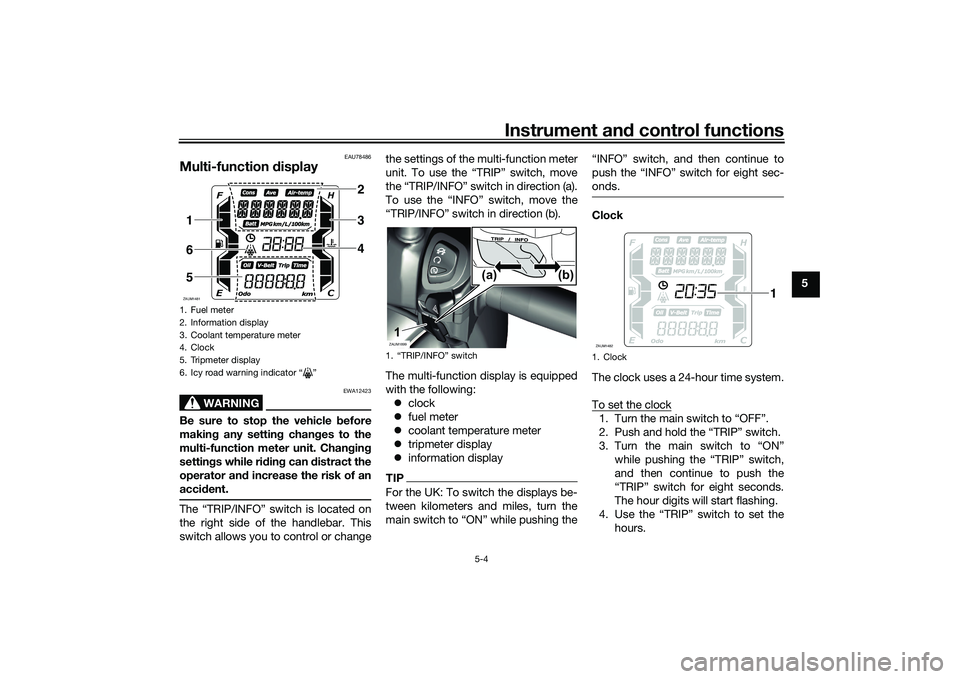
Instrument and control functions
5-4
5
EAU78486
Multi-function display
WARNING
EWA12423
Be sure to stop the vehicle before
makin g any settin g chan ges to the
multi-function meter unit. Chan gin g
settin gs while ri din g can distract the
operator an d increase the risk of an
acci dent.The “TRIP/INFO” switch is located on
the right side of the handlebar. This
switch allows you to control or change the settings of the multi-function meter
unit. To use the “TRIP” switch, move
the “TRIP/INFO” switch in direction (a).
To use the “INFO” switch, move the
“TRIP/INFO” switch in direction (b).
The multi-function display is equipped
with the following:
clock
fuel meter
coolant temperature meter
tripmeter display
information display
TIPFor the UK: To switch the displays be-
tween kilometers and miles, turn the
main switch to “ON” while pushing the “INFO” switch, and then continue to
push the “INFO” switch for eight sec-
onds.
Clock
The clock uses a 24-hour time system.
To set the clock1. Turn the main switch to “OFF”.
2. Push and hold the “TRIP” switch.
3. Turn the main switch to “ON”
while pushing the “TRIP” switch,
and then continue to push the
“TRIP” switch for eight seconds.
The hour digits will start flashing.
4. Use the “TRIP” switch to set the hours.
1. Fuel meter
2. Information display
3. Coolant temperature meter
4. Clock
5. Tripmeter display
6. Icy road warning indicator “ ”ZAUM1481
234
165
1. “TRIP/INFO” switchZAUM1899
(b)
(a)
1
1. ClockZAUM1482
1
UB9YE0E0.book Page 4 Wednesday, January 6, 2021 3:03 PM
Page 36 of 114
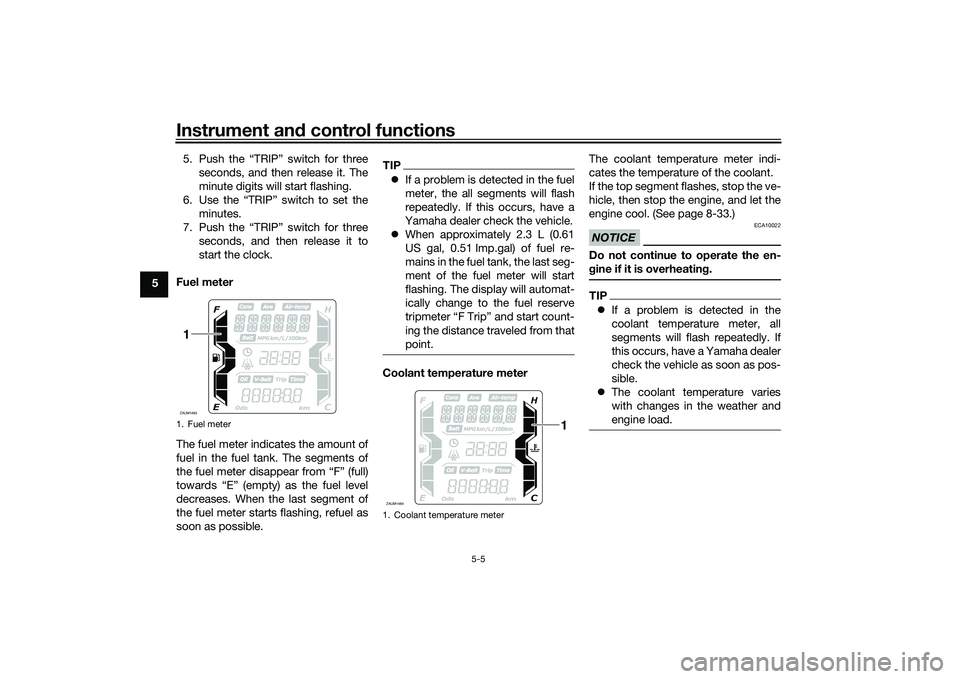
Instrument and control functions
5-5
5 5. Push the “TRIP” switch for three
seconds, and then release it. The
minute digits will start flashing.
6. Use the “TRIP” switch to set the minutes.
7. Push the “TRIP” switch for three seconds, and then release it to
start the clock.
Fuel meter
The fuel meter indicates the amount of
fuel in the fuel tank. The segments of
the fuel meter disappear from “F” (full)
towards “E” (empty) as the fuel level
decreases. When the last segment of
the fuel meter starts flashing, refuel as
soon as possible.
TIP If a problem is detected in the fuel
meter, the all segments will flash
repeatedly. If this occurs, have a
Yamaha dealer check the vehicle.
When approximately 2.3 L (0.61
US gal, 0.51 Imp.gal) of fuel re-
mains in the fuel tank, the last seg-
ment of the fuel meter will start
flashing. The display will automat-
ically change to the fuel reserve
tripmeter “F Trip” and start count-
ing the distance traveled from that
point.Coolant temperature meter The coolant temperature meter indi-
cates the temperature of the coolant.
If the top segment flashes, stop the ve-
hicle, then stop the engine, and let the
engine cool. (See page 8-33.)
NOTICE
ECA10022
Do not continue to operate the en-
g
ine if it is overheatin g.TIP If a problem is detected in the
coolant temperature meter, all
segments will flash repeatedly. If
this occurs, have a Yamaha dealer
check the vehicle as soon as pos-
sible.
The coolant temperature varies
with changes in the weather and
engine load.
1. Fuel meterZAUM14831
1. Coolant temperature meterZAUM1484
1
UB9YE0E0.book Page 5 Wednesday, January 6, 2021 3:03 PM
Page 37 of 114
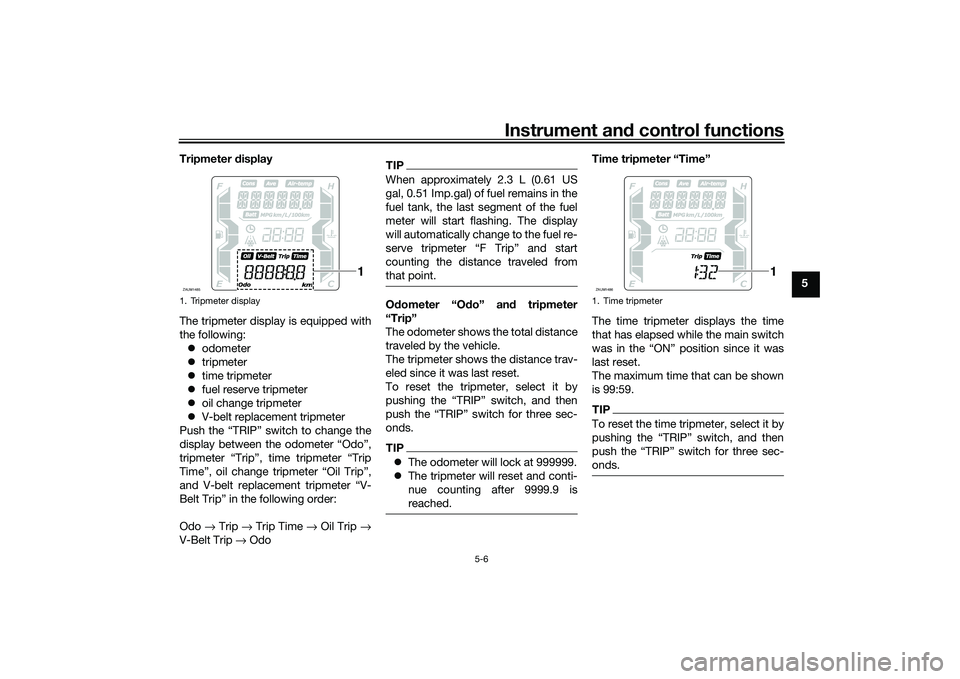
Instrument and control functions
5-6
5
Tripmeter
display
The tripmeter display is equipped with
the following: odometer
tripmeter
time tripmeter
fuel reserve tripmeter
oil change tripmeter
V-belt replacement tripmeter
Push the “TRIP” switch to change the
display between the odometer “Odo”,
tripmeter “Trip”, time tripmeter “Trip
Time”, oil change tripmeter “Oil Trip”,
and V-belt replacement tripmeter “V-
Belt Trip” in the following order:
Odo → Trip → Trip Time → Oil Trip →
V-Belt Trip → Odo
TIPWhen approximately 2.3 L (0.61 US
gal, 0.51 Imp.gal) of fuel remains in the
fuel tank, the last segment of the fuel
meter will start flashing. The display
will automatically change to the fuel re-
serve tripmeter “F Trip” and start
counting the distance traveled from
that point.Odometer “O do” an d tripmeter
“Trip”
The odometer shows the total distance
traveled by the vehicle.
The tripmeter shows the distance trav-
eled since it was last reset.
To reset the tripmeter, select it by
pushing the “TRIP” switch, and then
push the “TRIP” switch for three sec-
onds.TIP The odometer will lock at 999999.
The tripmeter will reset and conti-
nue counting after 9999.9 is
reached.
Time tripmeter “Time”
The time tripmeter displays the time
that has elapsed while the main switch
was in the “ON” position since it was
last reset.
The maximum time that can be shown
is 99:59.TIPTo reset the time tripmeter, select it by
pushing the “TRIP” switch, and then
push the “TRIP” switch for three sec-
onds.
1. Tripmeter displayZAUM1485
1
1. Time tripmeterZAUM1486
1
UB9YE0E0.book Page 6 Wednesday, January 6, 2021 3:03 PM
Page 38 of 114

Instrument and control functions
5-7
5 Fuel reserve tripmeter “F Trip”
When approximately 2.3 L (0.61 US
gal, 0.51 Imp.gal) of fuel remains in the
fuel tank, the last segment of the fuel
meter will start flashing. The display
will automatically change to the fuel re-
serve tripmeter “F Trip” and start
counting the distance traveled from
that point. In this case, push the “TRIP”
switch to switch the display in the fol-
lowing order:
F Trip
→ Oil Trip → V-Belt Trip → Odo
→ Trip → Trip Time → F Trip
To reset the fuel reserve tripmeter, se-
lect it by pushing the “TRIP” switch,
and then push the “TRIP” switch for
three seconds. The fuel reserve tripmeter will reset au-
tomatically and disappear after refuel-
ing and traveling 5 km (3 mi).
Oil chan
ge tripmeter “Oil Trip”
The oil change tripmeter shows the
distance traveled since the oil was last
changed.
The oil change indicator “OIL” flashes
at the initial 1000 km (600 mi), then at
6000 km (3500 mi) and every 6000 km
(3500 mi) thereafter to indicate that the
engine oil should be changed. After changing the engine oil, reset the
oil change indicator and the oil change
tripmeter. To reset them both, select
the oil change tripmeter, and then push
the “TRIP” switch for three seconds.
While the oil change tripmeter is flash-
ing, push the “TRIP” switch for 15 to 20
seconds. Release the “TRIP” switch,
and the oil trip value will reset to zero.
TIPIf the engine oil is changed before the
oil change indicator comes on (i.e., be-
fore the periodic oil change interval has
been reached), the oil change tripmeter
must be reset for the oil change indica-
tor to come on at the correct time.
1. Fuel reserve tripmeterZAUM1487
1
1. Oil change indicator “Oil”
2. Oil change tripmeterZAUM14881
2
UB9YE0E0.book Page 7 Wednesday, January 6, 2021 3:03 PM